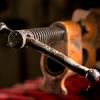So perhaps this isn't even true, but I get the sense that when we talk about taming tear out with hand planes, we are generally referring to the last finishing step, i.e. smoothing. This is where focus on super tight plane set-up and fine shavings seems to be.
But are not the previous planing steps (not across grain of course) as likely to cause tear out, and even more so if we're not taking those whispery fine shavings we often take with smoothers?
I ask because I feel like I treat every planing operation (e.g. even when jointing) as if I'm smoothing; taking fine shavings as to avoid tear out. I actually don't own a smoother, though I'm looking to change that.
If the grain is perfect, perhaps its a moot point. And if its horrendous, it'll probably be tough no matter what and again moot. I'm thinking here about the mid range hardwood with some mild reversing grain and the like. Isn't every operation other than roughing across the grain going to be treated the same? If we can't take a thick shaving, we can't. It we can, we can. It seems like every operation would need to be treated with the same slew of anti tear out measures we use for smoothing.
So what I'm wondering is: what differentiates the operations at all? I think I want to buy a smoother, but why? I already feel like I am smoothing when I use my #7. Am I using the 7 wrong?




 Reply With Quote
Reply With Quote








